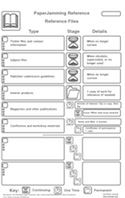 Last week I had the pleasure of being interviewed by Stephanie Diamond of the Marketing Message Blog for her podcast about PaperJamming. It was a pleasure chatting with her beforehand about how to apply PJ to business files, as well as during our relaxed, conversational interview. Thanks, Stephanie!
Last week I had the pleasure of being interviewed by Stephanie Diamond of the Marketing Message Blog for her podcast about PaperJamming. It was a pleasure chatting with her beforehand about how to apply PJ to business files, as well as during our relaxed, conversational interview. Thanks, Stephanie!
The podcast is now available on Stephanie’s blog here. In it, I talk about the ideas behind PaperJamming and describe the basic elements of Types and Stages for organizing, storing, and disposing paper and electronic files simply and easily . It’s a good where to order valium online introduction to the philosophy and principles behind the PaperJamming approach to personalized file management made fun.
Stephanie wrote that she finds PaperJamming to be a “brilliant conceptual idea. . . . Simple, elegant.” I hope you’ll give the podcast a listen and then head on over to the free downloadable templates and give PaperJamming a try for managing your business files.
Remember, just because your files have a life of their own doesn’t mean they have to run yours.

 Since their introduction last February, PaperJamming templates have remained among the top ten downloads from the Active Voice
Since their introduction last February, PaperJamming templates have remained among the top ten downloads from the Active Voice  Would you deliberately set fire to your family’s photo albums? Wantonly wave an electromagnet over cassette recordings of your child’s first words? Smash your copy of the White Album into fragments with a hammer? Shred your grandparents’ love letters?
Would you deliberately set fire to your family’s photo albums? Wantonly wave an electromagnet over cassette recordings of your child’s first words? Smash your copy of the White Album into fragments with a hammer? Shred your grandparents’ love letters?